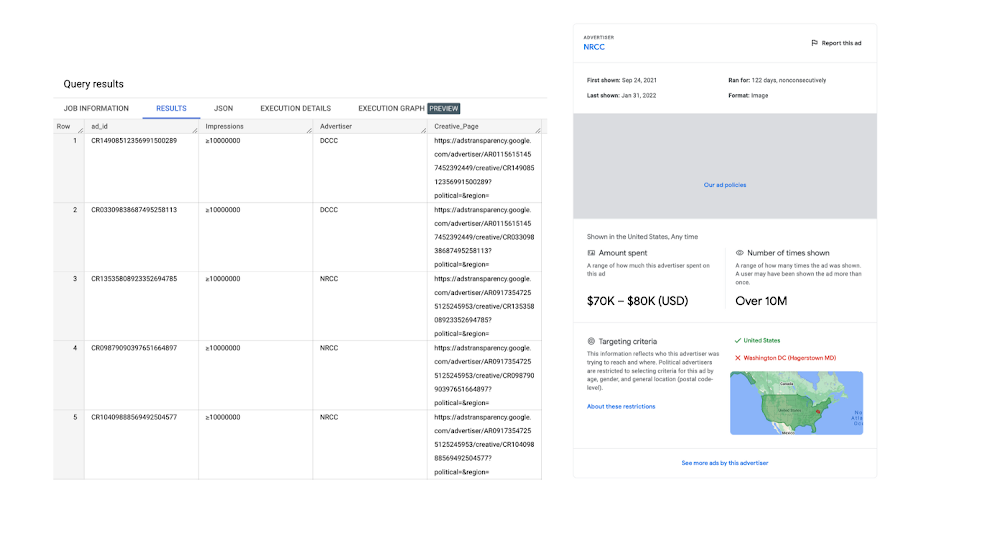
How to get started with the Political Ads Transparency Report dataset
In 2022 we saw several major elections wideness the globe. And as many countries prepare for elections in 2023 and 2024, we’d like to re-introduce a set of transparency tools that Google provides in the referendum razzmatazz space.
We know that referendum razzmatazz is an important component of the democratic process – candidates use ads to raise sensation well-nigh their campaigns, share information and engage potential voters. And we want people to have conviction in referendum ads they see on our platforms. That’s why, in 2018, Google launched its Election Razzmatazz Verification Policy, requiring all advertisers who wish to run referendum ads to well-constructed a verification process. This includes checking and confirming an advertiser’s identity, and ensuring they meet unrepealable eligibility requirements to run elections ads. We currently support referendum razzmatazz verification in over 35 countries.
Using the information placid via this verification process, Google moreover released itsPolitical Ads Transparency Report, which provides important insights and data well-nigh the ads published under our elections ads policy through Google Ads, YouTube and Google Display & Video 360.
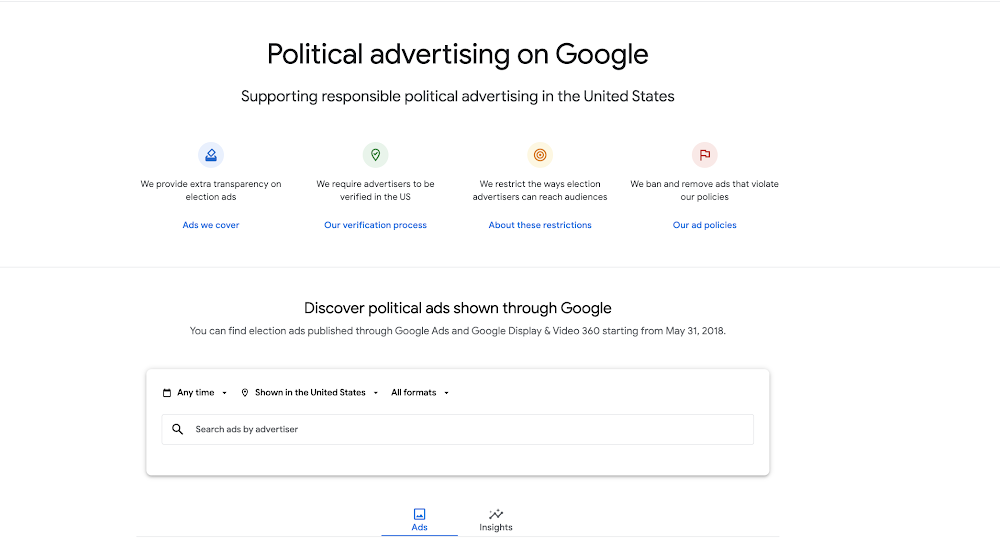
In this blog post, we will explore the data misogynist in the dataset, how to wangle it, and provide some examples of how it can be used. By the end of this post, you will have a largest understanding of the valuable insights this information can provide. We encourage all readers to partner with us by using this data to momentum greater peccancy in the referendum razzmatazz ecosystem.
Deeper swoop into the dataset
Let’s swoop deeper into what qualifies ads to be included in the Political Ads Transparency Report, and the data that is made misogynist in the dataset.
The dataset contains information on referendum ads run by verified advertisers wideness Google Ads, YouTube and Google Display & Video 360. The definition of an referendum ad on Google varies based on the country or region in question. For example, in the United States, advertisers who wish to run ads that mention a US state-level or federal candidate or office holder, political party, or ballot measure, must well-constructed our verification process verification process and the ads would subsequently towards in the Transparency Report.
The dataset– which begins in 2018 and retains ads for 7 years – includes the ads creatives themselves, as well as meaningful data on each ad, such as:
the regulars that was targeted (advertisers can only target referendum ads on four wholesale categories: age, gender, contextual and unstipulated location)
how many users saw the ad, and
the money spent on the ad.
These features are a prime example of Google's transferral to transparency and peccancy in the industry. Not only have journalists and research groups found the Transparency Report’s dataset incredibly useful for analyzing trends in referendum razzmatazz spending, but this data and the disclosures that trailblaze it moreover help empower voters with reliable information well-nigh the referendum ads they may see on Google.
Accessing the referendum ads dataset
You can wangle this dataset in two ways: through a user-friendly interface and with SQL using the public dataset misogynist in BigQuery.
The interface, which was updated in 2022, includes an interactive drop-down tool that allows users to select and filter specific advertisers, candidates, locations, ad formats, and timeframes. It then displays the resulting ads and automatically produces insights in the form of easy-to-understand data visualizations, such as tables and charts. You can moreover create reports on an advertiser’s spend over time and spend by location. This can provide valuable insights into who is spending money on referendum ads and where investments are happening.
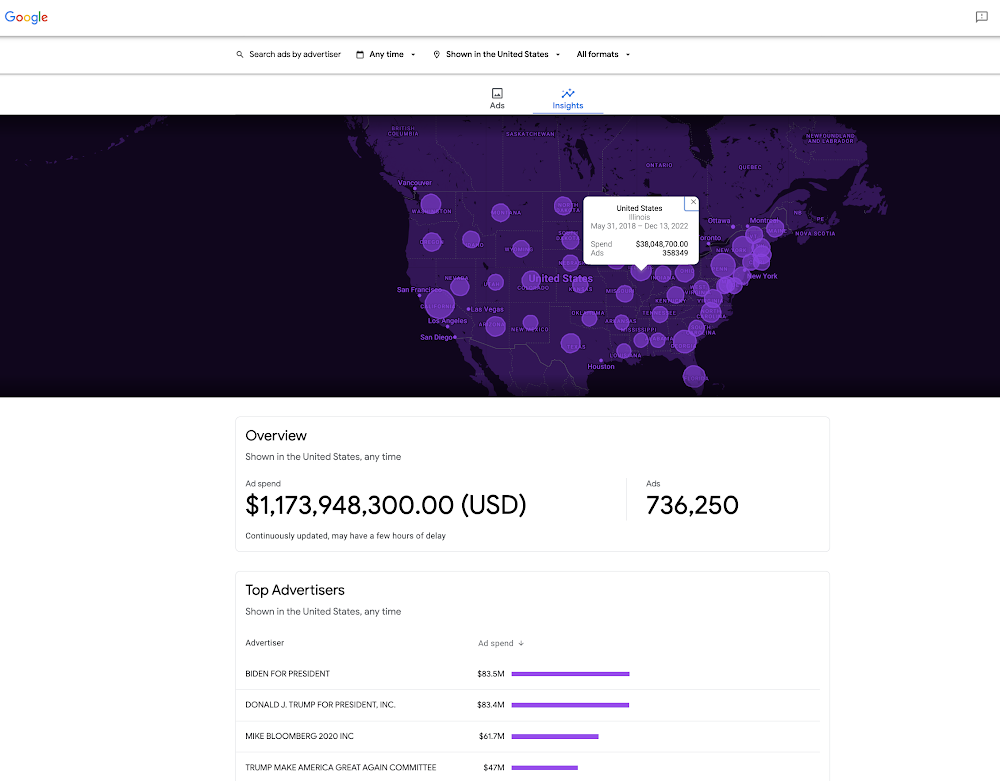
The BigQuery public dataset allows you to unriddle the data using SQL, including the worthiness to join the data with other public datasets, or their own private data loaded in BigQuery. It moreover opens up the possibility to wangle the data via the BigQuery API, visualize the data in Looker Studio or Connected Sheets, or integrate the data for any number of purposes wideness the services of Google Cloud.
We’ll delve into a few example ways you can search using the UI and wangle and unriddle the data in BigQuery.
Use cases for the referendum ads dataset
For research looking at ad dollars spent by location
With the user interface, you can search and unriddle ad spending over time in a specific location as wholesale as an unshortened country or as granular as a specific state or congressional district. For instance, the UI allows for search for spending inAlabama from 2018 to 2022. You can see top advertisers, and district by district spending amounts in Alabama.
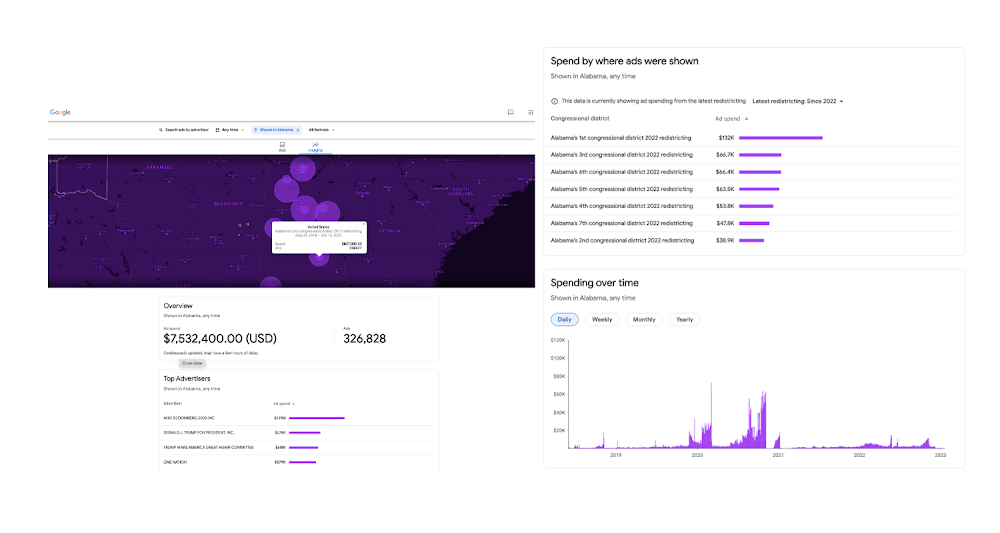
For research looking into targeted political advertisement
The dataset can moreover be used to identify political advertisers for a targeted demographic. For example, we can use BigQuery to write a query to identify political advertisers that targeted women in Florida over the 6 weeks leading up to the November 8, 2022 US midterm elections:
- code_block
- [StructValue([(u'code', u'SELECT\r\n CS.advertiser_name AS Advertiser,\r\n CONCAT("https://adstransparency.google.com/advertiser/", CS.advertiser_id, "?region=&political=") AS Advertiser_Page,\r\n COUNT(1) AS Number_of_Political_Ads,\r\n CS.gender_targeting,\r\n CS.geo_targeting_included\r\nFROM\r\n `bigquery-public-data.google_political_ads.creative_stats` AS CS\r\nWHERE\r\n REGEXP_CONTAINS(CS.gender_targeting,\r\n r"Female")\r\n AND REGEXP_CONTAINS(CS.geo_targeting_included,\r\n r"Florida")\r\n AND (CS.date_range_end BETWEEN DATE_SUB(DATE('2022-11-8'), INTERVAL 42 DAY) AND\r\n DATE('2022-11-08')\r\n OR CS.date_range_start BETWEEN DATE_SUB(DATE('2022-11-8'), INTERVAL 42 DAY) AND\r\n DATE('2022-11-08'))\r\n\r\nGROUP BY\r\n 1,2,4,5\r\nORDER BY 3 desc'), (u'language', u'lang-sql'), (u'caption', <wagtail.wagtailcore.rich_text.RichText object at 0x3ee5db754210>)])]
After running this query in the BigQuery console, the results show 149 ads, with details including the advertiser's name, forerunner page, gender and unstipulated location targeting of the ad , and the total number of referendum ads that forerunner ran for this demographic.
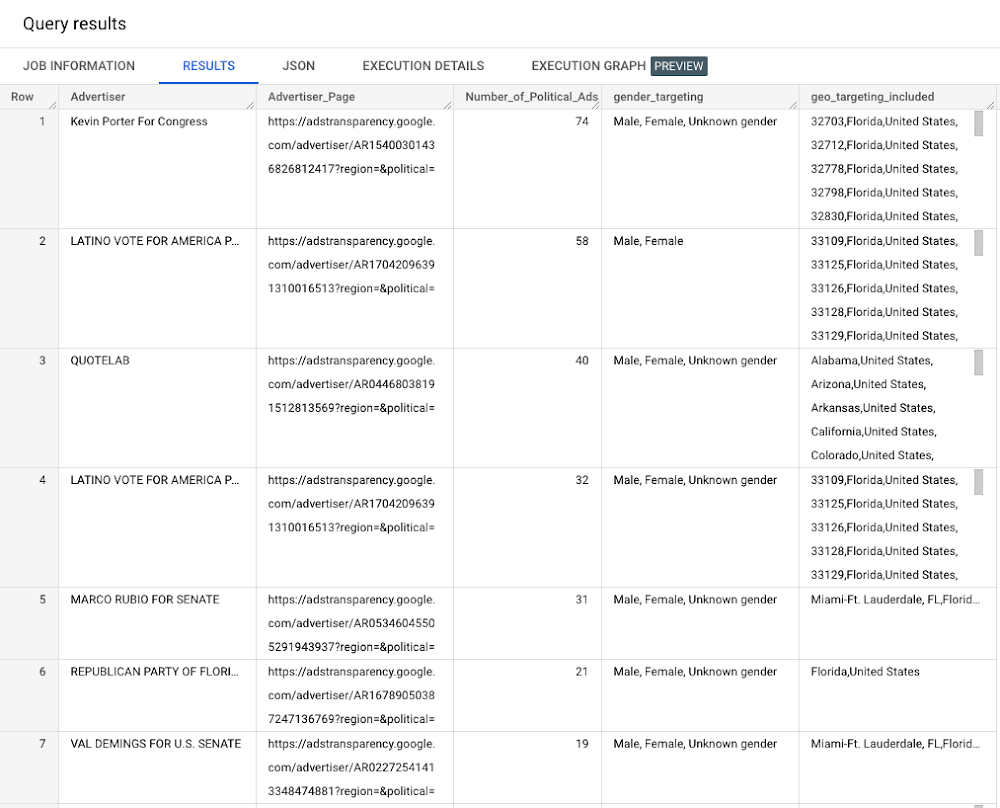
For researching referendum ads with upper impressions
Another use specimen is analyzing referendum ads with large numbers of impressions, for example those that have reached over 1 million impressions. To do this, we can use the pursuit SQL query in BigQuery:
- code_block
- [StructValue([(u'code', u'SELECT\r\n CS.ad_id,\r\n CS.impressions AS Impressions,\r\n CS.advertiser_name AS Advertiser,\r\n CONCAT("https://adstransparency.google.com/advertiser/", CS.advertiser_id, "/creative/", CS.ad_id, "?political=®ion=") AS Creative_Page,\r\nFROM\r\n `bigquery-public-data.google_political_ads.creative_stats` AS CS\r\nWHERE\r\n CS.impressions = "1000000-1250000"\r\n OR CS.impressions = "1250000-1500000"\r\n OR CS.impressions = "1500000-1750000"\r\n OR CS.impressions = "1750000-2000000"\r\n OR CS.impressions = "2000000-2250000"\r\n OR CS.impressions = "2250000-2500000"\r\n OR CS.impressions = "2500000-3000000"\r\n OR CS.impressions = "3000000-3500000"\r\n OR CS.impressions = "3500000-4000000"\r\n OR CS.impressions = "4000000-4500000"\r\n OR CS.impressions = "4500000-5000000"\r\n OR CS.impressions = "5000000-6000000"\r\n OR CS.impressions = "6000000-7000000"\r\n OR CS.impressions = "7000000-8000000"\r\n OR CS.impressions = "8000000-9000000"\r\n OR CS.impressions = "9000000-10000000"\r\n OR CS.impressions = "\u226510000000";'), (u'language', u'lang-sql'), (u'caption', <wagtail.wagtailcore.rich_text.RichText object at 0x3ee5d8fdf990>)])]
The query returned over 24,790 ads and each row contains spare information like the referendum ad id (which can be useful to find the ad in the UI), impressions, forerunner name and a link to the referendum ad details. If you click on the link for the election ad details, you’ll see plane increasingly information on that specific ad.

Next steps
These are just a few of the many ways to use the Political Ads Transparency Report dataset.
A unconfined way to get familiar with the dataset is through its visual UI; for example, you can trammels out all the referendum ads run by a specific advertiser. Then you can start running SQL queries on the BigQuery dataset at no forfeit by creating a BigQuery sandbox. The BigQuery sandbox enables you to query data within the limits of the free tier without needing a credit card. If you decide to enable billing and go whilom the self-ruling tier threshold, you are subject to regular BigQuery pricing.
To learn increasingly well-nigh the Political Ads Transparency Report dataset, throne to the Marketplace listing.
We would like to thank Juan Uribe (Software Engineer) and Michael Yu (Software Engineer) for their help in creating this blog post.


